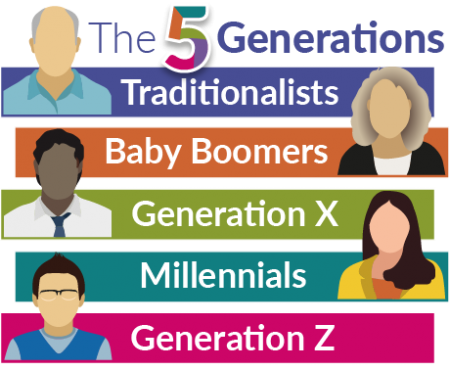5 Generations in the Workplace: How to Manage Them All
How many generations are working in the workplace?
As of 2023, there are five generations in the workplace: Baby boomers, millennials, Generation Z (Gen Z), traditionalists, and Generation X (Gen X). The age range covered by these groups, which the Bureau of Labor Statistics (BLS) further divides into decade-specific categories, is 16 to 75 years old. Every generation brings something special to the workplace. While younger generations provide forward-thinking new ideas and innovation, older generations often bring industrial expertise and experience.
A baby boomer’s decades of life experience may have given them refined soft skills, such as public speaking or good bargaining. Given that they began their careers during a pandemic and disruptive technology changes, members of Generation Z could be better at adjusting and thinking creatively. However, these characteristics differ across individuals.
Understanding generational differences in the workplace might help you create a more respectful and cohesive atmosphere if your team consists of workers of different ages. Additionally, greater communication and teamwork take the place of implicit prejudice when one is aware of and sympathetic to other work styles.
What are the 5 generations in the workplace?
- The Silent Generation, often referred to as traditionalists, were born between 1928 and 1945, at the height of the Great Depression and World War II. Despite the fact that the youngest members are in their late 70s, their share in the workforce is increasing as fewer people retire. Approximately 12% of those over 75 will be employed full-time by 2030. That is an increase above the only 5% in 2000.
- Baby boomers: Those born between 1946 and 1964, who retired in large numbers during the epidemic, helped younger generations fill employment. Throughout their careers, baby boomers held an average of 12 jobs, just half of which came after the age of 24. They have a thorough awareness of their chosen sector and work function due to their steadfast commitment to their professions.
- The members of Generation X were born between 1965 and 1980. They are renowned for their independence and were sometimes referred to as “latchkey kids.” Many of them were alone at home after school before both parents came home from work since they grew up in an era when more women were leaving the house to pursue careers.
- Born between 1981 and 1996, millennials, often known as Generation Y, are those who were present during both technology shifts. Their birth preceded the widespread use of personal computers and the internet.
- Born between 1997 and 2012, Generation Z is the newest generation to enter the workforce. Coming of age with cell phones, social networking, and quickly advancing new technology, Gen Zers are digital natives.
How to close the generational gap
- Conduct instruction
In the workplace, training serves as a bridge between younger and older generations. There is plenty for each person to teach the other. Gen Z may forge new paths toward more inclusivity and diversity, while baby boomers might offer insights on certain industries or professions. Encourage team members from every generation to conduct training sessions in accordance with their areas of competence and knowledge to promote horizontal information exchanges. It creates a transparent learning atmosphere and demonstrates to junior staff members the value of their involvement. - Let dialogue flow
Find out the forms of communication your team members like, and be willing to try new ones. Group chats, email, and in-person meetings are all powerful tools on their own. Identifying a solution that suits all parties prevents misunderstandings and communicates to them that the group respects their communication style. - Avoid passing judgment
Workplace preferences and viewpoints are influenced by generational experiences. To fully comprehend others’ perspectives, be open-minded and actively listen to what they have to say. In order to overcome prejudices and promote intergenerational cooperation, team building activities, cooperative work, and upward communication are all beneficial. - Diverse is beneficial.Working with people from different generations encourages everyone to be more empathetic and open-minded. It brings together diverse viewpoints, backgrounds, and skill sets, enhancing the learning and development opportunities for each team member.

